
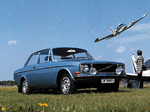
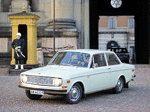
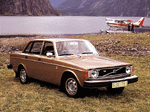
Background and Profile of the Volvo 140
By Jack Cluer
The 140 Series was introduced into the UK in early 1967. The early examples used the B18 engine as in the 120's. To start with, only the 4 door models were imported, the 142 (manual transmission only) models arrived later during 1967 and the estates arrived in the Spring of 1968. I have had many Members express confusion over the Model designation system so I will try to explain this before I go on: The 140 Series had a system in which the second digit referred to the number of cylinders - 4, (whereas the 164 has 6 cylinders). The third digit referred to the number of doors - 142 - 2 doors, 144 - 4 doors, 145 - 5 door estate. The suffix 'S' indicated twin carburettors whilst 'E' indicated electronic fuel injection. The built-in roll bar in the roof space, anti-burst door locks, dual circuit braking system and a collapsible steering column were standard features, along with fully reclining front seats which were also fitted with head restraints. Fully fitted carpets were a standard feature, an improvement on the starkness of the rubber flooring as fitted to previous Volvo models. The estate versions (145 & 145S) offered enormous load carrying potential, with 71 cu ft capacity, with the rear seats folded down. Uprated rear springs coped with the extra weight carrying possibilities. Even an extra, rear facing, child seat was available as an optional extra for those with large families. The under-floor storage area in the rear of the estates is very useful for those inevitable bits and pieces that we all 'must' have on board! The saloon boot is also very large but as with many cars of the period, has rather a high sill. (Even my 1988 760 suffered from the same problem, I'm glad Volvo got it right with the 850s and the later 940s and 960s!
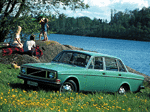
In the Autumn of 1968, the B20, 2 litre, emission control engine was introduced in either single (Stromberg CD 175) carburettor (B20A), or twin carbs. (B20B). The Bosch electronic fuel injection (B20E) version arrived in 1971 which also had leather seats and a sunshine roof. About this time Laycock de Normanville overdrive became available on the saloons but not on the UK estates. A matter soon put to right in my case as I soon converted my own 145's, (Betsy's) gearbox to accept an overdrive unit and at the same time I fitted the remote gearchange as fitted on the 1800's which is a vast improvement over the long 'stark' lever as fitted to the '71 versions. The 72 gearchange was a remote unit. I will mention more about modifications later. Unfortunately, in 1969, the 2 door 142 was no longer imported into the UK. A shame this as the 142 was (and still is) a favourite for Historic Rallying and many people enjoy the features of a 2 door car. In 1972, side impact bars were fitted as standard in the doors and the instrument panel changed from the 'strip' speedometer, to the more conventional circular dial type. Towards the end of their production run, the fuel tank was re- sited, being brought forward behind the rear axle and the rear silencer moved to the rear. This was to reduce the possibility of the fuel tank being ruptured in the event of a rear end shunt. During its production run, the 140 has had three different front grills. The early ones were a one-piece, polished aluminium version (to which you could fit a headlamp wash-wipe accessory kit), the 1971, three piece anodized aluminium grill (to which you could not fit the H/L W/W kit - I know, I tried!!) and finally a more 'chunky' version which accompanied wider and larger indicators, the following year larger, impact absorbing bumpers were fitted. The 140s (and the 160's) were finally discontinued in 1974 but very many features and indeed parts were incorporated into the 240 Series, indeed body design remained basically unchanged until the 240's finally finished last year.
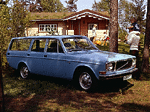
The 140's were unfortunately referred to as 'tanks' by some who did not know better because they were built to a very high standard of safety, years ahead of their contemporaries. They were built to withstand Scandinavian winters and to provide the safest transport possible for cars of that age and continue to do so today in most respects. Although the 140 is a 'big' car, the turning circle of 2lft makes it quite easy to get into tight places, the only drawback being the absence of power steering. (I would make a small fortune if I could devise a PAS system for the 140's! I do believe though that it was available in Australia but I have not had confirmation of this). All you can do is to ensure that the steering joints on the wishbone suspension system are absolutely 100% top condition or they will seize up, creak and generally stiffen up the steering badly. It is important to keep the tyre pressures correct too. The 240's were changed over to McPherson strut suspension and rack and pinion steering instead of the cam and peg as on the 140's, which resulted in a much lighter steering. I have had Members criticise the somewhat heavy clutch action of the 140's. Again, being a cable operated system, a certain amount of friction is generated here and the clutch fitted MUST be a genuine Volvo one. Others will work - for a while - but there is a mysterious ingredient in the 'Blue Box' version which seems to work better and for longer. The clutch cable 'mod' which I've mentioned so many times is essential for speedy cable changes in the event of sudden breakage. This has been the only time I've ever been let down by Betsy although it is possible to drive a 140 without a clutch, with care (and lots of luck at traffic lights and roundabouts!) - (Engage first gear, handbrake 'off, crank engine and away you go! Actually changing gear is easy if you get the revs just right). A get-you-home tip, as used by the AA and RAC involves pulling out the broken inner cable and then passing a replacement length of ‘Bowden' cable through the remaining outer cable, looping it on to the clutch pedal and making fast the lower end to the clutch release arm with a solderless nipple.

I've always found the 140's seats to be very comfortable but the Pirelli webbing tends to perish and sag after a while (18 stone doesn't help either, I suppose!) At least it can very easily be replaced after a visit to your local upholsterers suppliers. Volvos can still rust, just like any other car but looked after they can remain bodily sound long after lesser cars have gone to the crusher. There are a few places to check though: inner and outer wings, the latter being 'bolt on' which makes access behind them much easier. Behind and below the headlamps, around the bonnet hinges on the scuttle, around the door pillar bases and where the rear wheel arch meets the sill. Sometimes rust can occur along the roof guttering. The floor pans should be looked at although in my experience, I've not seen that much evidence of serious underbody rust. The majority of under floor panels are galvanised anyway. The spare wheel wells are regular rust spots as is the edge of the rear panel where the boot closes. The tailgates on the estates have a nasty habit of rusting along the lower, inside edge, just below the glass. The edges of the rear window frames of the estates are also favourite rust areas. Around the front windscreen, especially along the lower edge you can often see tell-tale signs that the metal clips which retain the stainless steel windscreen trim in place have rusted away, thus allowing the trim to lift away and for the scuttle panel to rust. (See later mod for this trim). Fortunately, body panels are still readily available, either from Volvo or from 'pattem parts' makers although I would suggest caution here as the quality sometimes leaves much to be desired even though the Volvo ones are a bit more expensive.
As regards the mechanical components, I wish they built 'em like that today! ! A more straightforward engine - in-line, 4 cylinder, pushrod operated valve, unit with a simple carburettor (or two), with a basic ignition system which can easily be understood and serviced by the most basically trained enthusiast! The engines are rugged and have a very long life - 150,000 - 200,000 miles is a not uncommon life before a re-build is necessary. As with all things though, regular servicing pays dividends. Regular oil and filter changes (Genuine Volvo filters PLEASE!!), regular changing of the flame trap filter (or better still, fitting the later type which is bigger and the mod only costs a fiver), pays dividends. The engines tend to be a bit 'rattly' at the best of times, having a valve clearance of between 0.016in to 0.022in according to model. The engines are unusual in that, instead of the more conventional timing chain to operate the camshaft, gears are used. A steel one is fitted to the crankshaft and a ‘Tufnol' (fibre) one to the camshaft. After a while. backlash occurs between the gear teeth and there is a resultant 'tappety-sounding' knock from this area. Only a replacement gear kit will rectify this. An 'all steel' kit is available for competition or general use if you don't mind the 'whine'! - I think it was standard on the 164's.
Some modifications that can be carried out on the 140's include: The first favourite, I think, is an overdrive unit! This gives a more relaxed feel to cruising speeds and gives a better fuel consumption. A complete unit from a donor car will include the O/D itself plus the gearbox cross member, a shorter propeller shaft, a longer speedometer cable and the switch and wiring. A Kenlowe electric fan allows the removal of the mechanical one (some have a viscous coupling). I've had a Kenlowe on Betsy for over 20 years and have never regretted it. Electronic ignition is excellent and I've always advocated the Lumenition 'optronic' system. This does away with the points and condenser and again, has proved to be utterly reliable - no points to change and set is only one of the advantages! (In the highly unlikely event of failure, it is only a quick job to slip the points and condenser back in anyway!) The front and rear crankshaft oil seals were originally felt ones and they tend to fail after a while. The answer here is to either replace both the timing cover and rear crankshaft oil seal housing with the 164 verions, which have neoprene 'lip' seals fitted or, to machine out your own timing cover and rear cover to accept the lip seals, which is what I did on Betsy. As the 140s tend to be a bit 'lollopy', a heavier anti-roll bar can improve things - IPD of Portland, Oregon, USA. (Charlton Road Auto Spares - Tel 0117 9679639 are UK agents), can supply them today together with a vast number of 'goodies' and tuning equipment for 140s. I fitted Girling gas shock absorbers when the original ones got a bit tired. Referring to windscreens again, the later 240 aluminium type trim can be fitted which include a neoprene seal which is held in place with plastic clips instead of the rust-prone steel ones. The 'screen can be replaced with the 240 type including a 'top-tint' or 'Sundym' glare strip if you wish. Internally, the 'R Sport' round instrument panel could be fitted, replacing the early, strip type speedo panel. There is no end to the possibilities of modifying a 140, some of which the purist, concours enthusiast, may scorn but which will increase the pleasure and fun of owning one. I have a central locking kit which I keep promising to get round to fitting and also an electric (front only) window winder kit too.
I still think that from the enthusiast owner's point of view the 140 is one of the finest cars that Volvo have ever built. I think so anyway!! They are the almost perfect DIY car, everything is so straightforward and easy to work on except changing the clutch cable, without the 'Jack-mod!!'
Volvo 142, 144 and 145 production, engine and gearbox information
Volvo 142. 2-Door Saloon / Sedan
| Chassis Name | Model Year | Model Name | Production ID | Ch. Nr. from | Nr Built | Engine | Gearbox |
|---|---|---|---|---|---|---|---|
| Volvo 142 | 1967 | 142, 142S | M | 1 | 1500 | B18A, B18B | M40, M41, BW35 |
| Volvo 142 | 1968 | 142, 142S | P | 1500 | 51400 | B18A, B18B | M40, M41, BW35 |
| Volvo 142 | 1969 | 142, 142S | S | 52900 | 59500 | B20A, B20B | M40, M41, BW35 |
| Volvo 142 | 1970 | 142, 142S | T | 112400 | 66560 | B20A, B20B | M40, M41, BW35 |
| Volvo 142 | 1971 | 142S, 142E | U | 178960 | 70970 | B20B, B20E | M40, M41, BW35 |
| Volvo 142 | 1972 | 142S, 142E | W | 249930 | 73470 | B20B, B20F | M40, M41, BW35 |
| Volvo 142 | 1973 | 142DL, 142GL | Y | 323400 | 70550 | B20B, B20F | M40, M41, BW35 |
| Volvo 142 | 1974 | 142DL, 142GL | A | 393950 | 64356 | B20B, B20F | M40, M41, BW35 |
Total 142 cars produced: 458300
Volvo 144. 4-Door Saloon / Sedan
| Chassis Name | Model Year | Model Name | Production ID | Ch. Nr. from | Nr Built | Engine | Gearbox |
|---|---|---|---|---|---|---|---|
| Volvo 144 | 1967 | 144, 144S | M | 1 | 37100 | B18A, B18B | M40, M41, BW35 |
| Volvo 144 | 1968 | 144, 144S | P | 37100 | 52700 | B18A, B18B | M40, M41, BW35 |
| Volvo 144 | 1969 | 144, 144S | S | 89800 | 48900 | B20A, B20B | M40, M41, BW35 |
| Volvo 144 | 1970 | 144, 144S | T | 138700 | 55440 | B20A, B20B | M40, M41, BW35 |
| Volvo 144 | 1971 | 144, 144S | U | 194140 | 68930 | B20A, B20B | M40, M41, BW35 |
| Volvo 144 | 1972 | 144S, 144E | W | 263070 | 77030 | B20B, B20F | M40, M41, BW35 |
| Volvo 144 | 1973 | 144DL, 144GL | Y | 340100 | 87900 | B20B, B20F | M40, M41, BW35 |
| Volvo 144 | 1974 | 144DL, 144GL | A | 428000 | 91768 | B20B, B20F | M40, M41, BW35 |
Total numbers of 144 cars produced: 519768
Volvo 145 Estate / Wagon
| Chassis Name | Model Year | Model Name | Production ID | Ch. Nr. from | Nr Built | Engine | Gearbox |
|---|---|---|---|---|---|---|---|
| Volvo 145 | 1968 | 145S | P | 1 | 9200 | B18B | M40, BW35 |
| Volvo 145 | 1969 | 145, 145S | S | 9200 | 21700 | B20A, B20B | M40, BW35 |
| Volvo 145 | 1970 | 145, 145S | T | 30900 | 30700 | B20A, B20B | M40, BW35 |
| Volvo 145 | 1971 | 145, 145S | U | 61600 | 41780 | B20A, B20B | M40, BW35 |
| Volvo 145 | 1972 | 145S, 145E | W | 103380 | 50350 | B20B, B20F | M40, BW35 |
| Volvo 145 | 1973 | 145DL, 145GL | Y | 153730 | 56320 | B20B, B20F | M40, BW35 |
| Volvo 145 | 1974 | 145DL, 145GL | A | 210050 | 58277 | B20B, B20F | M40, BW35 |
Total 145 cars made: 268327
Legal | Privacy | Contact Us | Search | Site Map
Volvo Owners' Club Limited® 1962-2025

